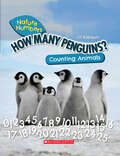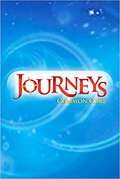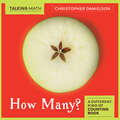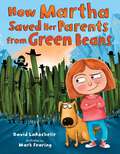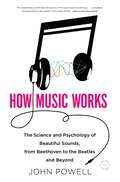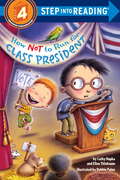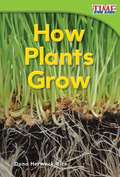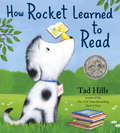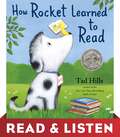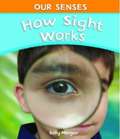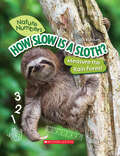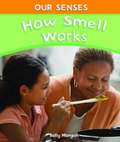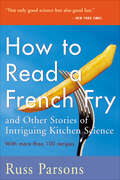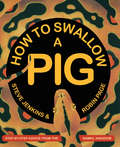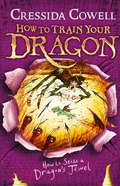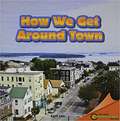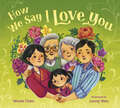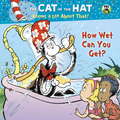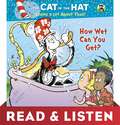- Table View
- List View
How Many Penguins?: Counting Animals 0-100 (Nature Numbers)
by Jill EsbaumIn Nature Numbers, math is beautiful, recognizable, and all around us! Highly engaging pictures of animals and nature scenes, along with cool chalk illustrations, are used to introduce basic math concepts and encourage kids to see a world of numbers all around them.K-2 math concepts include counting 1-100. This book encourages kids to count groups of 10 animals with amazing nature pictures and chalk illustrations!
How Many Planets Circle the Sun?: And Other Questions About Our Solar System (Good Question!)
by M. CarsonWhy is there life on earth? How did Saturn get its rings? Which planet is biggest, which ones hottest—and which has a cloud named Scooter? Take a trip into outer space to learn about the asteroid belt, Martian volcanoes, dwarf planets, and other fascinating facts about our universe.
How Many Stars in the Sky? (Journeys)
by Lenny Hort James E. RansomeNIMAC-sourced textbook <P><P>Lexile Measure: AD500L
How Many? (Talking Math Ser.)
by Christopher DanielsonTalking math with your child is fun and easy with this better approach to counting!Written by a math educator, this innovative book encourages critical thinking and sparks memorable mathematical conversations. You and your child decide what to count on each page. You have many choices, and the longer you look, the more possibilities you'll notice. There are no wrong answers in this book. As long as you're talking about what you see, think, and wonder, you're talking math!
How Martha Saved Her Parents from Green Beans
by David LaRochelleMartha HATES green beans. When some mean, green bandits stroll into town, anyone who ever said "Eat your green beans" is in big trouble. But when the beans kidnap Martha's parents, Martha is forced to take action. She can think of only one way to stop the villainous veggies from taking over her town, and it&’s not pretty...or tasty. Featuring absurdly funny text and illustrations with attitude, this is a hilarious read for everyone – even the pickiest of eaters.
How Mountains Are Made
by Kathleen Weidner Zoehfeld James Graham HaleEven though Mount Everest measures 29,028 feet high, it may be growing about two inches a year. A mountain might be thousands of feet high, but it can still grow taller or shorter each year. Mountains are created when the huge plates that make up the earth's outer shell very slowly pull and push against one another. Read and find out about all the different kinds of mountains.
How Mountains Are Made (Let's-Read-and-Find-Out Science 2)
by Kathleen Weidner ZoehfeldRead and find out about how mountains are made in this colorfully illustrated nonfiction picture book.A mountain might be thousands of feet high, but it can still grow taller or shorter each year. This classic picture book explores how mountains are made—including how Mount Everest grew from a flat plain under an ocean to become 29,028 feet tall.How Mountains Are Made features simple activities and fascinating cross-sections of the earth’s moving crust that clearly explain plate tectonics. Both text and artwork were vetted for accuracy by an expert in the field.This is a clear and appealing science book for early elementary age kids, both at home and in the classroom. It's a Level 2 Let's-Read-and-Find-Out, which means the book explores more challenging concepts for children in the primary grades. The 100+ titles in this leading nonfiction series are:hands-on and visualacclaimed and trustedgreat for classroomsTop 10 reasons to love LRFOs:Entertain and educate at the same timeHave appealing, child-centered topicsDevelopmentally appropriate for emerging readersFocused; answering questions instead of using survey approachEmploy engaging picture book quality illustrationsUse simple charts and graphics to improve visual literacy skillsFeature hands-on activities to engage young scientistsMeet national science education standardsWritten/illustrated by award-winning authors/illustrators & vetted by an expert in the fieldOver 130 titles in print, meeting a wide range of kids' scientific interestsBooks in this series support the Common Core Learning Standards, Next Generation Science Standards, and the Science, Technology, Engineering, and Math (STEM) standards. Let's-Read-and-Find-Out is the winner of the American Association for the Advancement of Science/Subaru Science Books & Films Prize for Outstanding Science Series.
How Music Works: The Science and Psychology of Beautiful Sounds, from Beethoven to the Beatles and Beyond
by John PowellWhat makes a musical note different from any other sound? How can you tell if you have perfect pitch? Why do 10 violins sound only twice as loud as one? Do your Bob Dylan albums sound better on CD or vinyl? John Powell, a scientist and musician, answers these questions and many more in HOW MUSIC WORKS, an intriguing and original guide to acoustics. In a clear, accessible, and engaging voice, Powell fascinates the reader with his delightful descriptions of the science and psychology lurking beneath the surface of music. With lively discussions of the secrets behind harmony, timbre, keys, chords, loudness, musical composition, and more, HOW MUSIC WORKS will be treasured by music lovers everywhere.
How Not to Run for Class President
by Debbie Palen Ellen Vandenberg Catherine A. HapkaLooking for a fun, light introduction to the campaign process? Join the brothers from the How Not to . . . series as they navigate a class election! Third grader Will couldn't care less about boring school politics. But when his friend Chelsea proposes a Reading Buddy program that would require Will to hang out with the kindergartners (and therefore his little brother, Steve), he makes an impulsive decision to run against her! Supportive brother that he is, Steve takes full responsibility for managing his brother's campaign . . . and things quickly spiral out of control. This fun reader gently teaches what it means to be a responsible politician, and even gets some election basics into the mix. A hilarious tool to kick off classroom units on elections! Step 4 Readers use challenging vocabulary and short paragraphs to tell exciting stories. These books are for newly independent readers who read simple sentences with confidence.From the Trade Paperback edition.
How People Learned to Fly
by Fran HodgkinsIn this book you find out about the many obstacles that have been overcome so planes and people can soar through the sky. <P><P>[This text is listed as an example that meets Common Core Standards in English language arts for K-1 at http://www.corestandards.org.]
How Plants Grow (Time For Kids®: Informational Text)
by Dona Herweck RiceBeginning readers explore the steps to make plants grow! Readers will learn about various parts of the plant including seeds, roots, and leaves in this engaging nonfiction title. Featuring vivid, clear photos and simple, informational text, even the most reluctant reader will be captivated!
How Rocket Learned to Read (Rocket)
by Tad HillsThis sweet picture book starring an irresistible dog named Rocket and his teacher, a little yellow bird, is perfect for back-to-school! Follow along as Rocket masters the alphabet, sounds out words, and finally . . . learns to read all on his own. With a story that makes reading fun-and will even help listeners learn to read-this book is ideal for kindergarten classrooms and story hour or as a gift for that beginning reader. Fresh, charming art by Tad Hills, theNew York Timesbestselling author/illu...
How Rocket Learned to Read: Read & Listen Edition (Rocket)
by Tad HillsLearn to read with this Read & Listen edition of the New York Times bestselling picture book, starring an irresistible dog named Rocket and his teacher, a little yellow bird. Follow along as Rocket masters the alphabet, sounds out words, and finally . . . learns to read all on his own!With a story that makes reading fun—and will even help listeners learn to read—this book is ideal for kindergarten classrooms and story hour or as a gift for that beginning reader. Fresh, charming art by Tad Hills, the New York Times bestselling author-illustrator of Duck & Goose, will make this a favorite.This ebook includes Read & Listen audio narration.
How Sight Works (Our Senses)
by Sally MorganThis book introduces the sense of sight and how it helps us function in everyday life.
How Slow Is a Sloth?: Measure the Rainforest (Nature Numbers)
by Jill EsbaumIn Nature Numbers, math is beautiful, recognizable, and all around us! Highly engaging pictures of animals and nature scenes, along with cool chalk illustrations, are used to introduce basic math concepts and encourage kids to see a world of numbers all around them.K-2 math concepts include measuring. This book explores measuring elements of the rainforest with amazing nature pictures and chalk illustrations!
How Smell Works (Our Senses)
by Sally MorganWhy do some things smell good and other things smell bad? This book explains where our sense of smell comes from and how it helps us function in everyday life. A lively, straightforward narrative presents scientific concepts for young readers and an activity is included enhance the learning experience.
How Steven the Bear Invented S'mores (Steven the Bear)
by Scott HallHow Steven the Bear Invented S’mores is a read aloud picture book with fun life lessons and colorful illustrations. Steven the Bear and his friends are excited to go on their very first camping adventure. After being sure to pack and prepare well, the Bear Bunch heads out to find the perfect campsite. They set up camp and spend their day hiking, bird watching, and finding animals. After a day full of fun, Steven and the Bear Bunch sit down to toast marshmallows. That’s when Steven has a brilliant idea…? Join Steven the Bear and his friends in this first of many adventures!
How To Read A French Fry and Other Stories of Intriguing Kitchen Science: And Other Stories of Intriguing Kitchen Science
by Russ ParsonsWhy can you stick your hand into a 450-degree oven but not into 212-degree boiling water without burning it? Why does fish taste different from meat? Why do you cook pork differently from beef? Why should you always start cooking dried beans in cold water, not warm? Why should you never cook a Vidalia onion? What's the only kind of marinade that&’s really an effective tenderizer? Why is strawberry-rhubarb a good combination, scientifically speaking? And why don&’t potatoes fried in fresh oil ever brown completely, no matter how long they're cooked? &“Cooking is full of questions that science can help you answer, questions that can make you a better cook,&” writes the award-winning Los Angeles Times food editor, Russ Parsons. In this entertaining book packed with fascinating tidbits, Parsons explores the science behind such basic cooking methods as chopping, mixing, frying, roasting, boiling, and baking. You&’ll learn why soaking beans can&’t offset their gaseous effects, why green vegetables shouldn&’t be cooked under a lid for long, which fruits you can buy unripe and which you should buy fully ripened, which thickener to choose for your turkey gravy, and which piecrust is foolproof for a beginner. Along the way, Parsons slips in hundreds of cooking tips, provocative trivia, and touches of wit that make his scientific explanations go down smoothly. He also includes more than a hundred recipes that deliciously exemplify the principles he describes, from Tuscan Potato Chips and Crisp-Skinned Salmon on Creamy Leeks and Cabbage to Chocolate Pots de Creme and Ultimate Strawberry Shortcake.
How To Swallow A Pig: Step-by-step Advice From The Animal Kingdom
by Steve Jenkins Robin PageIn the latest eye-catching escape into the kingdom of Animalia, Steve Jenkins and Robin Page reveal the skills animals use to survive in the wild in an imaginative and humorous how-to format. With step-by-step instructions, readers learn about specific behaviors; how to catch thousands of fish like a humpback whale or how to sew up a nest like a tailorbird. This fascinating and fun illustrated nonfiction melds science, art, biology, and the environment together in a detailed and well-researched book about animals who live and survive in our world today.
How To Train Your Dragon: Book 10 (How To Train Your Dragon Ser. #10)
by Cressida CowellRead the HILARIOUS books that inspired the HOW TO TRAIN YOUR DRAGON films! Hiccup Horrendous Haddock the Third is a smallish Viking with a longish name. Hiccup's father is chief of the Hairy Hooligan tribe which means Hiccup is the Hope and the Heir to the Hairy Hooligan throne - but most of the time Hiccup feels like a very ordinary boy, finding it hard to be a Hero. When we last left Hiccup things were getting very dark indeed. The Dragon Rebellion has begun. Snotlout is the new Chief of the Hooligan Tribe. Stoick has been banished and given the Slavemark. And Alvin the Treacherous has EIGHT of the King's Lost Things, and has been proclaimed the new King of the Wilderwest ... But what can Hiccup do, now all alone and in exile, hunted by both humans and dragons? Can he find the Dragon Jewel, mankind's last and only hope and become the Hero once again?***Please note this ebook is TEXT ONLY and does not include the illustrations that appear in the printed book.***READ ALL 12 BOOKS IN THE SERIES!You don't have to read the books in order, but if you want to, this is the right order:1. How to Train Your Dragon2. How to Be a Pirate3. How to Speak Dragonese4. How to Cheat a Dragon's Curse 5. How to Twist a Dragon's Tale6. A Hero's Guide to Deadly Dragons7. How to Ride a Dragon's Storm8. How to Break a Dragon's Heart9. How to Steal a Dragon's Sword10. How to Seize a Dragon's Jewel11. How to Betray a Dragon's Hero12. How to Fight a Dragon's FuryHow to Train Your Dragon is now a major DreamWorks franchise starring Gerard Butler, Cate Blanchett and Jonah Hill and the TV series, Riders of Berk, can be seen on CBeebies and Cartoon Network.
How Water Gets from Treatment Plants to Toilet Bowls (Here To There Ser.)
by Megan Cooley Petersonutilities; homes; community helpers; plumbers
How We Get Around Town (Infomax Common Core Readers)
by April LeeExplains the different ways people can get around town, including walking, biking, and driving.
How We Say I Love You
by Nicole ChenIn this heartwarming picture book, an Asian American girl shares how her family expresses their love for one another through actions rather than words.How do you tell your family that you love them? For Hana, love is all around her: Mom stirs love into a steaming pot of xifan. Dad cheers with love at her soccer game. Hana says good night with love by rubbing her grandma's feet and pouring her grandpa his sleepy tea. And as the light fades, Hana's parents tuck her into bed and give her a good night kiss. So many families express their love in all they do for one another, every day. Here is a book that wraps you in a hug and invites your family to share their own special ways of showing love.
How Wet Can You Get? (Pictureback(R))
by Joe Mathieu Aristides Ruiz Tish RabeSally and Nick are playing in the rain--and getting really muddy! So when the Cat in the Hat offers to show them how animals get clean, the kids are keen to find out. But can Sally and Nick really get rid of the mud by taking dust baths, like a sparrow? Or by licking themselves, like a lion? And where are they going to find an oxpecker to pick it off them, like a hippo has? (Besides, oxpeckers tickle!) Maybe there's a better way for a kid to get clean? Based on an episode of the new PBS Kids program The Cat in the Hat Knows a Lot About That!, this 16-page Pictureback comes with a sheet of adorable stickers featuring all the mud encrusted characters.
How Wet Can You Get? (Pictureback(R))
by Tish RabeRead and listen along with the Cat in the Hat! Sally and Nick are playing in the rain—and getting really muddy! So when the Cat in the Hat offers to show them how animals get clean, the kids are keen to find out. But can Sally and Nick really get rid of the mud by taking dust baths, like a sparrow? Or by licking themselves, like a lion? And where are they going to find an oxpecker to pick it off them, like a hippo has? (Besides, oxpeckers tickle!) Maybe there's a better way for a kid to get clean? Based on an episode of the hit PBS Kids tv show The Cat in the Hat Knows a Lot About That!This ebook includes Read & Listen audio narration.
